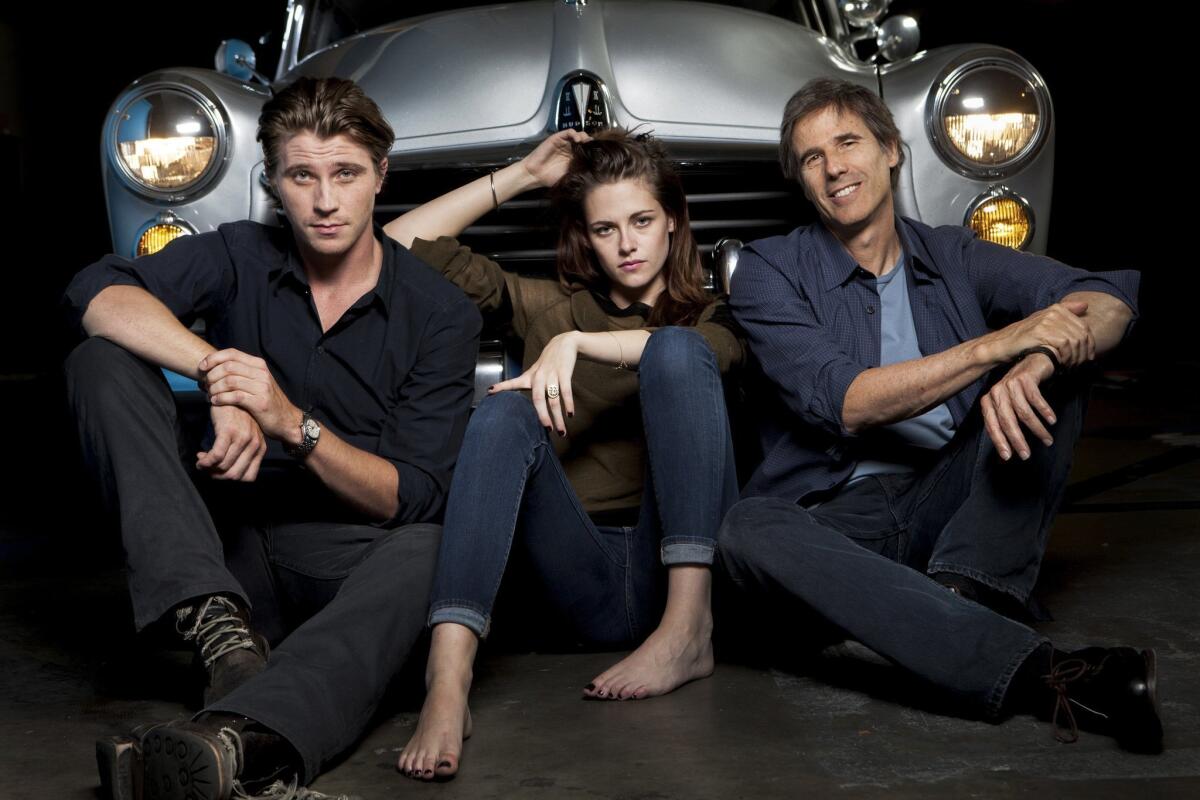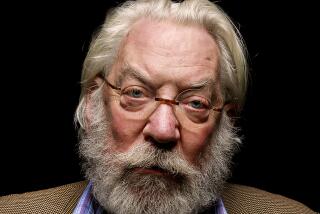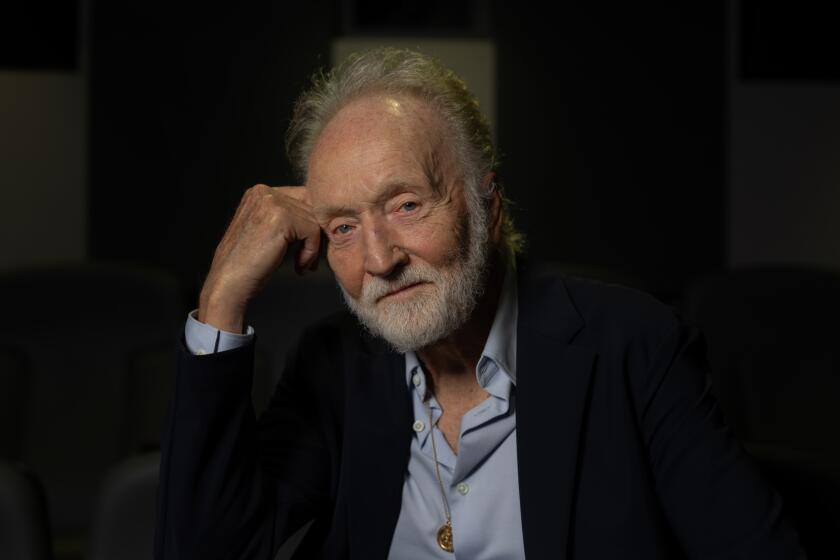The Hudson and ‘On the Road’ are finally in gear

From inside the rocket-shaped time capsule of a silver 1949 Hudson Super Six, West Hollywood looked astonishingly modern to Brazilian director Walter Salles.
Salles, who has devoted the last eight years to adapting Jack Kerouac’s “On the Road” for the screen, rode past men holding hands on Santa Monica Boulevard, past the green neon signs of shops selling medicinal marijuana, past a Starbucks — and another Starbucks — and another Starbucks. It was a streetscape that would have been unimaginable in Kerouac’s time — both in the freedoms of the passersby and the homogeneity of the businesses.
“So many quests from that time were achieved,” Salles said, craning his neck over the Hudson’s roomy front bench seat toward screenwriter José Rivera and actor Garrett Hedlund, who plays Dean Moriarty, the voracious free-spirit Kerouac based on his real-life Beat muse, Neal Cassady. “They were ingrained in all of us.”
OSCAR BUZZMETER 2013: Best Picture
Since its publication in 1957, “On the Road,” which opens Dec. 21, has inspired countless road trips. This short sojourn was in search of tacos on a warm autumn evening, with driver Press Kale, a Hudson collector from Buena Park who had lent this car to Salles to shoot test footage. (Another 1949 Hudson was used in the movie).
As they rode through the streets of L.A. — which Kerouac called the “loneliest and most brutal of American cities” — this group of travelers described the many speed bumps they and others hit while making “On the Road” and reflected on the story’s implications for a modern audience.
Written and published during the deep freeze of the Cold War, Kerouac’s novel follows young writer Sal Paradise — an avatar for Kerouac, played in the film by English actor Sam Riley — as he makes a series of cross-country trips with the intoxicating Dean and Dean’s girlfriend, Marylou (Kristen Stewart), and encounters other Beat-era characters including Allen Ginsberg-inspired Carlo Marx (Tom Sturridge) and William Burroughs embodiment Old Bull Lee (Viggo Mortensen).
As soon as Kerouac published his travelogue of sex, drugs and jazz, he lobbied to get it on the big screen — in 1957 he wrote a letter to Marlon Brando suggesting that he buy the rights and star as Dean, with Kerouac playing Sal. “What I wanta do is re-do the theater and the cinema in America, give it a spontaneous dash,” Kerouac wrote. Brando declined.
In 1979, Francis Ford Coppola bought the book, and over the next 25 years several possible screen iterations came and went — there were scripts by novelist Russell Banks, war correspondent Michael Herr, poet Barry Gifford and Francis and his son Roman Coppola. One version of the film had Coppola directing and Brad Pitt and Ethan Hawke as Dean and Sal. But the book’s discursive narrative and the budgetary demands of a period film shot on the road proved a deterrent for financiers.
In 2004, after Salles, 56, premiered “The Motorcycle Diaries,” at the Sundance Film Festival, Coppola’s production company, American Zoetrope, approached him about making “On the Road.” It seemed a logical fit — Salles’ film was a coming-of-age road movie about another variety of 1950s revolutionary, Che Guevara. Salles quickly enlisted Rivera, the Puerto Rican playwright who wrote “The Motorcycle Diaries” screenplay, sending him eight prior scripts. Rivera didn’t read them.
A breakthrough
To facilitate their research, Salles decided to make a documentary in which he retraced Sal Paradise’s road trip and interviewed Beat-era writers. While shooting footage for the documentary in Kerouac’s hometown of Lowell, Mass., in 2005, Salles was let into another world by Kerouac’s brother-in-law, John Sampas. Kerouac originally wrote “On the Road” on a 120-foot-long scroll — and the scroll version varied dramatically from the book.
Sampas allowed Salles and Rivera to read a copy of the scroll, which would be published two years later. The scroll contained an intriguing change from the book readers knew as “On the Road,” one that would inform Rivera’s script. The book starts, “I first met Dean not long after my wife and I split up.” The scroll begins, “I first met Dean not long after my father died.”
The scroll version underscores some of the sad subtext within the buoyant narrative. It is also racier than the novel, yet one of the challenges of adapting the book for a contemporary audience remained — conveying just how risque the characters’ actions were for their era.
VIDEO: The Envelope Screening Series
“It was a highly conservative time period,” Rivera said. “At one point they’re driving while Truman’s giving his inaugural speech on the radio and he’s talking about communism as this scourge on humanity and you really realize how tightly controlled American society was, in terms of politics, sexuality, pop culture. These guys, whether they were self-conscious or not, were rebelling on all fronts — sexually, socially, in terms of drug use, even racially, they really were so far ahead.”
Finding young actors who could capture both the time period and the spirit of adventure would be a challenge — the character of Dean, in particular, would demand a potent brand of old-fashioned masculine charisma.
Hedlund, 28, first auditioned in 2006 before being cast as the lead in the 2010 films “Tron: Legacy” and “Country Strong.” He read a scene in which Dean tells Sal about almost committing suicide and then riffs on a four-hour orgy he attended.
“When Garrett finished reading, there was such electricity in the air that it was almost palpable,” Salles said. “There was a quality of observation and a sense of wit that was very original and that seemed to pertain to that generation.”
Hedlund enthusiastically joined Salles and Rivera in their research. He quickly mastered handling the Hudson at high speeds and at one point he learned, via Skype, how to open a benzedrine inhaler with a beer bottle from Al Hinkle, the man who inspired Kerouac’s character, Ed Dunkel.
“Because of him we used a beer bottle,” Hedlund said. “He said half of one strip could give you the energy of Kenyan runner for eight hours, and if you did a whole strip it would keep you up for 24 hours. It was funny to see his face when I pulled out the mock bennie inhaler. His eyes lit up, ‘There’s that little beauty.’”
As casting proceeded, so did an enervating search for financing. In the end the bulk of the less-than-$25-million budget for a film of a groundbreaking American novel came from French sources, for a Brazilian director, a Puerto Rican screenwriter and a cast including British actors in key roles. Asked whether the foreign financing wasn’t a bit surprising, Rivera raised his eyebrows. “I believe the word you’re searching for is ‘ironic,’” he said.
One generational change the filmmakers had to contend with was Kerouac’s women — Marylou, who was based on Cassady’s real teenage bride, LuAnne Henderson, and Camille (Kirsten Dunst), based on his wife, Carolyn Cassady, have been criticized as mere sexual objects in “On the Road.”
“We didn’t want them to be victims,” Rivera said. “The girls that just get left behind, get pregnant and cry. We really wanted to make them three-dimensional heroes in their own worlds.”
As a result, Marylou spends much of the film warming men’s beds, but she makes her own decisions. “The reason the book has never been irrelevant is that people have certain fundamental desires,” said Stewart, who couldn’t come along for the ride in the Hudson but spoke by phone. “Marylou would have been well ahead of her time even now.”
Off the highway
As Kale steered the Hudson into the parking lot of El Coyote restaurant, a woman in a neighboring car flashed a thumbs-up. In the book and in Salles’ film, the Hudson, which Cassady is said to have bought for a small down payment and later had repossessed, is as much a character as any person. It also has the benefit of being spacious enough for a small crew.
In 2010, more than 50 years after it was first published, cameras finally rolled on “On the Road” — in Montreal, Argentina, Chile, New Orleans, Arizona, Mexico City, San Francisco and Calgary, Canada, varying somewhat from Kerouac’s route for the sake of scenery. For one sequence, a goggles-clad Hedlund drove the Hudson in the Andes during a blizzard, howling out his window while Salles sat in the passenger seat holding a camera, with another mounted on the hood.
Among the chief difficulties while shooting was avoiding Wal-Mart and McDonald’s.
“If you take the exact same path as Kerouac took, you drive 1,000 miles and you see the same fast-food shops every here and there,” Salles said. “You have to go further and take the smaller roads, those that are not in the map. When you do that, you end up understanding that there is still a world out there that is genuine and raw and unspoiled. You can still find it, but you have to go much further.”
“On the Road” premiered at the Cannes Film festival in May to mixed reviews — critics praised Hedlund’s seductive performance and cinematographer Eric Gautier’s lush camera work, but some felt that in its faithfulness to Kerouac’s text, the movie sacrificed the book’s feverish thrill.
After shooting wrapped, Hedlund drove the 1949 Hudson used in the film from L.A. to San Francisco to the Beat Museum, with Neal Cassady’s son, John, and Hinkle along for much of the ride.
For the movie’s makers, the journey of “On the Road” will never really end, Salles said. “When you gain distance from where you live,” Salles said as we wound down the historic Route 66 stretch of Santa Monica Boulevard, “you better understand who you are.”
PHOTOS AND MORE
VIDEO: The making of ‘Argo,’ ‘Les Miz’ and more
The Envelope: Awards Insider
PHOTOS: NC-17 movies: Ratings explained
More to Read
Only good movies
Get the Indie Focus newsletter, Mark Olsen's weekly guide to the world of cinema.
You may occasionally receive promotional content from the Los Angeles Times.











